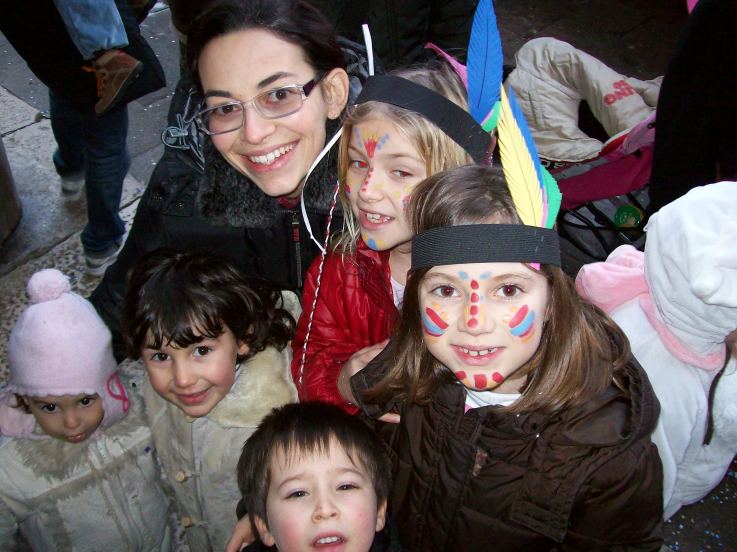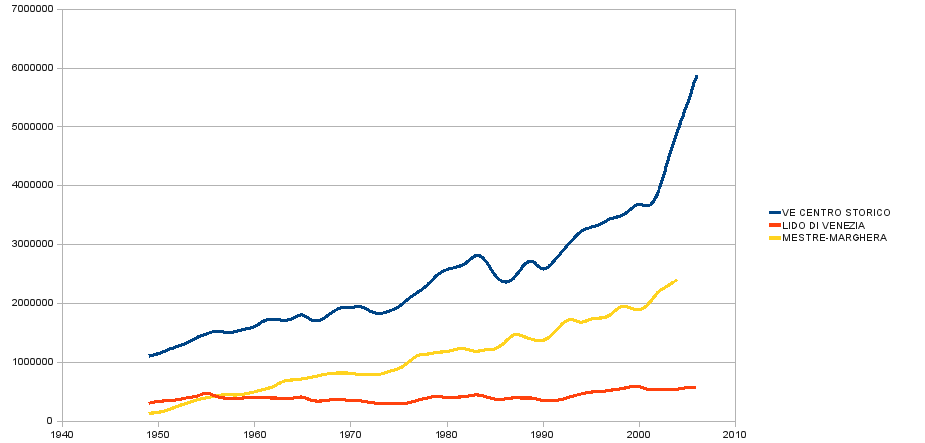Venice used to be a big city. Actually, it used to be a small empire, but that’s a few centuries ago now.
Venice grew slowly from 130,000 in 1861 to almost 175,000 persons in 1951, but since then the city has almost collapsed, with an exodus from the city on water to the city on land, Mestre and Marghera. In 1961 Venice had lost 20% of the population just a decade before, and another 20% ten years later. In 1981 the population was just over half of the 1951 level, and now the population is just around 60,000, about 1/3 of the 1951 population.
If the current trend continues the last Venetian will move away in 2040.
Most Venetians have moved to the mainland nearby, the towns of Mestre and Marghera,where you can live a “normal” life, with a house, a car, shopping malls and all the other modern amenities you don’t have so easily in the lagoon.
The population of Mestre and Marghera has grown even faster than the decline in Venice, with a recent drop. The population in the rest of the lagoon, on the Lido and the smaller islands, is mostly stable.
The population of the entire municipality of Venice, lagoon and mainland was 316,000 in 1951,
(Venice: blue; Lido and islands: red; mainland: yellow – source: Venice city council)
As the Venetians flee, the tourists move in.
It is hard quantify tourism in Venice. The graph below show the number of night spent in hotels, B&Bs, camp site etc, in Venice, in the lagoon and on the mainland in the last sixty year. This is one measure, but it excludes all the day tourists who come in just for a day, by car, pullman, train or cruiseship, but there really isn’t any reliable way to count them.
In 1951 less than half a million tourists spent just over 1,129,000 nights in hotels in the city of Venice, with another 60,000 tourists on the Lido and 49,000 on the mainland.
In 2007 there were 2,2 million tourists in Venice for 5,9 million nights, with 188,000 tourists on the Lido and 1,3 million on the mainland. In all there were 3,6 million tourists for almost 9 million nights.
There is no reliable way of measuring the total number of tourists in Venice, but most estimates are between 15 and 20 millions tourists every year.
This means that currently, on an average day in Venice, there are more tourists than inhabitants, and on a busy day there are probably twice as many.
Venice is now in a situation where it is economically dependent on the high number of tourists, and as a consequence many of the few remaining residents of the city are feeling that the city administration care more for the needs of the tourists than for the needs of the people who actually live there and who make the city live in return.
Many old traditions, such as the ancient feasts of the city, are now almost abandoned by the city dwellers and mostly attended by tourists, to an such an extent that at this years carnival groups of residents had staged their own counter carnival celebration, with an American Indian theme, to protest they way they feel they’re living in a reservation, almost as strangers in their own city.

(young Venetian indians – photo by Massimo Fadalti – venessia.ning.com)
If the Venetians continue to vote with their feet as they have for over half a century now, the city of Venice will become little more than a fancy theme park.


Leave a Reply